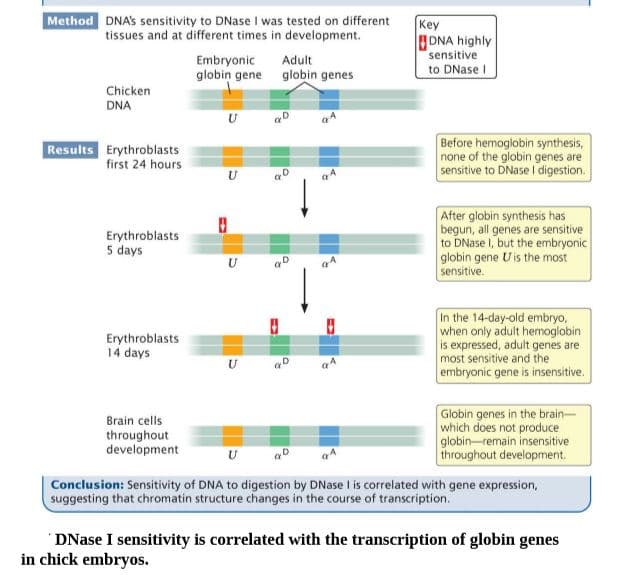Method DNAS sensitivity to DNase I was tested on different tissues and at different times in development. Key DNA highly sensitive to DNase I Embryonic globin gene globin genes Adult Chicken DNA U aD Results Erythroblasts first 24 hours Before hemoglobin synthesis, none of the globin genes are sensitive to DNase I digestion. a4 After globin synthesis has begun, all genes are sensitive to DNase I, but the embryonic globin gene Uis the most sensitive. Erythroblasts 5 days In the 14-day-old embryo, when only adult hemoglobin is expressed, adult genes are most sensitive and the embryonic gene is insensitive. Erythroblasts 14 days Globin genes in the brain- which does not produce globin-remain insensitive throughout development. Brain cells throughout development Conclusion: Sensitivity of DNA to digestion by DNase I is correlated with gene expression, suggesting that chromatin structure changes in the course of transcription. DNase I sensitivity is correlated with the transcription of globin genes in chick embryos.
Method DNAS sensitivity to DNase I was tested on different tissues and at different times in development. Key DNA highly sensitive to DNase I Embryonic globin gene globin genes Adult Chicken DNA U aD Results Erythroblasts first 24 hours Before hemoglobin synthesis, none of the globin genes are sensitive to DNase I digestion. a4 After globin synthesis has begun, all genes are sensitive to DNase I, but the embryonic globin gene Uis the most sensitive. Erythroblasts 5 days In the 14-day-old embryo, when only adult hemoglobin is expressed, adult genes are most sensitive and the embryonic gene is insensitive. Erythroblasts 14 days Globin genes in the brain- which does not produce globin-remain insensitive throughout development. Brain cells throughout development Conclusion: Sensitivity of DNA to digestion by DNase I is correlated with gene expression, suggesting that chromatin structure changes in the course of transcription. DNase I sensitivity is correlated with the transcription of globin genes in chick embryos.
Biochemistry
6th Edition
ISBN:9781305577206
Author:Reginald H. Garrett, Charles M. Grisham
Publisher:Reginald H. Garrett, Charles M. Grisham
Chapter30: Protein Synthesis
Section: Chapter Questions
Problem 1P
Related questions
Question
Based on the sensitivity of DNA to DNase I, as illustrated in Figure , which type of chicken hemoglobin (embryonic or adult) is likely to be produced in the highest quantity in the following tissues and developmental stages?
Q. Erythroblasts at day 5

Transcribed Image Text:Method DNAS sensitivity to DNase I was tested on different
tissues and at different times in development.
Key
DNA highly
sensitive
to DNase I
Embryonic
globin gene globin genes
Adult
Chicken
DNA
U aD
Results Erythroblasts
first 24 hours
Before hemoglobin synthesis,
none of the globin genes are
sensitive to DNase I digestion.
a4
After globin synthesis has
begun, all genes are sensitive
to DNase I, but the embryonic
globin gene Uis the most
sensitive.
Erythroblasts
5 days
In the 14-day-old embryo,
when only adult hemoglobin
is expressed, adult genes are
most sensitive and the
embryonic gene is insensitive.
Erythroblasts
14 days
Globin genes in the brain-
which does not produce
globin-remain insensitive
throughout development.
Brain cells
throughout
development
Conclusion: Sensitivity of DNA to digestion by DNase I is correlated with gene expression,
suggesting that chromatin structure changes in the course of transcription.
DNase I sensitivity is correlated with the transcription of globin genes
in chick embryos.
Expert Solution
This question has been solved!
Explore an expertly crafted, step-by-step solution for a thorough understanding of key concepts.
This is a popular solution!
Trending now
This is a popular solution!
Step by step
Solved in 2 steps

Knowledge Booster
Learn more about
Need a deep-dive on the concept behind this application? Look no further. Learn more about this topic, biology and related others by exploring similar questions and additional content below.Recommended textbooks for you

Biochemistry
Biochemistry
ISBN:
9781305577206
Author:
Reginald H. Garrett, Charles M. Grisham
Publisher:
Cengage Learning

Biochemistry
Biochemistry
ISBN:
9781305577206
Author:
Reginald H. Garrett, Charles M. Grisham
Publisher:
Cengage Learning